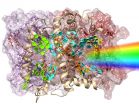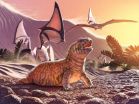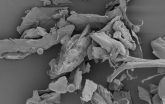(Press-News.org) Some dying stars suffer from 'irregular heartbeats', research led by astronomers at the University of Warwick has discovered.
The research confirms rapid brightening events in otherwise normal pulsating white dwarfs, which are stars in the final stage of their life cycles.
In addition to the regular rhythm from pulsations they expected on the white dwarf PG1149+057, which cause the star to get a few percent brighter and fainter every few minutes, the researchers also observed something completely unexpected every few days: arrhythmic, massive outbursts, which broke the star's regular pulse and significantly heated up its surface for many hours.
The discovery was made possible by using the planet-hunting spacecraft Kepler, which stares unblinkingly at a small patch of sky, uninterrupted by clouds or sunrises.
Led by Dr JJ Hermes of the University of Warwick's Astrophysics Group, the astronomers targeted the Kepler spacecraft on a specific star in the constellation Virgo, PG1149+057, which is roughly 120 light years from Earth.
Dr Hermes explains:
"We have essentially found rogue waves in a pulsating star, akin to 'irregular heartbeats'. These were truly a surprise to see: we have been watching pulsating white dwarfs for more than 50 years now from the ground, and only by being able to stare uninterrupted for months from space have we been able to catch these events."
The star with the irregular beat, PG1149+057, is a pulsating white dwarf, which is the burnt-out core of an evolved star, an extremely dense star which is almost entirely made up of carbon and oxygen. Our Sun will eventually become a white dwarf in more than six billion years, after it runs out of its nuclear fuel.
White dwarfs have been known to pulsate for decades, and some are exceptional clocks, with pulsations that have kept nearly perfect time for more than 40 years. Pulsations are believed to be a naturally occurring stage when a white dwarf reaches the right temperature to generate a mix of partially ionized hydrogen atoms at its surface.
That mix of excited atoms can store up and then release energy, causing the star to resonate with pulsations characteristically every few minutes. Astronomers can use the regular periods of these pulsations just like seismologists use earthquakes on Earth, to see below the surface of the star into its exotic interior. This was why astronomers targeted PG1149+057 with Kepler, hoping to learn more about its dense core. In the process, they caught a new glimpse at these unexpected outbursts.
"These are highly energetic events, which can raise the star's overall brightness by more than 15% and its overall temperature by more than 750 degrees in a matter of an hour," said Dr Hermes. "For context, the Sun will only increase in overall brightness by about 1% over the next 100 million years."
Interestingly, this is not the only white dwarf to show an irregular pulse. Recently, the Kepler spacecraft witnessed the first example of these strange outbursts while studying another white dwarf, KIC 4552982, which was observed from space for more than 2.5 years.
There is a narrow range of surface temperatures where pulsations can be excited in white dwarfs, and so far irregularities have only been seen in the coolest of those that pulsate. Thus, these irregular outbursts may not be just an oddity; they have the potential to change the way astronomers understand how pulsations, the regular heartbeats, ultimately cease in white dwarfs.
"The theory of stellar pulsations has long failed to explain why pulsations in white dwarfs stop at the temperature we observe them to," argues Keaton Bell of the University of Texas at Austin, who analysed the first pulsating white dwarf to show an irregular heartbeat, KIC 4552982. "That both stars exhibiting this new outburst phenomenon are right at the temperature where pulsations shut down suggests that the outbursts could be the key to revealing the missing physics in our pulsation theory."
Astronomers are still trying to settle on an explanation for these never-before-seen outbursts. Given the similarity between the first two stars to show this behaviour, they suspect it might have to do with how the pulsation waves interact with themselves, perhaps via a resonance.
"Ultimately, this may be a new type of nonlinear behaviour that is triggered when the amplitude of a pulsation passes a certain threshold, perhaps similar to rogue waves on the open seas here on Earth, which are massive, spontaneous waves that can be many times larger than average surface waves," said Dr Hermes. "Still, this is a fresh discovery from observations, and there may be more to these irregular stellar heartbeats than we can imagine yet."
The research, A second case of outbursts in a pulsating white dwarf observed by Kepler, is published in the current issue of the Astrophysical Journal Letters. The first case of outbursts in a pulsating white dwarf was published in the 10 August 2015 issue of the Astrophysical Journal.
INFORMATION:
Computing --the creation of supercomputers, above all-- enables scientists and engineers to analyse highly complex physical processes using simulation techniques. In this case, researchers in the UPV/EHU's Department of Computer Architecture and Technology and the Department of Materials Physics are collaborating with researchers from various universities (including the Universidade de Coimbra, Universitat de Barcelona, Lawrence Livermore National Laboratory, Martin-Luther-Universität Halle-Wittenberg, University of Liege) to analyse the photosynthesis process basing ...
(PHILADELPHIA) -- Alternative medicines are widely thought to be at least harmless and very often helpful for a wide range of discomforts and illnesses. However, although they're marketed as "natural," they often contain active ingredients that can react chemically and biologically with other therapies. Researchers performed a comprehensive review of all of the medications taken by senior oncology patients and found that as 26 percent were using complementary or alternative medicines (CAM), in a report published August 12th, in the Journal of Geriatric Oncology.
"Currently, ...
(Boston)--Educating clinicians on how to safely prescribe opioids can help decrease opioid misuse among chronic pain sufferers.
These findings, which appear online in the journal Pain Medicine, confirm that education can empower clinicians to make more informed clinical decisions about initiating, continuing, changing or discontinuing opioids for patients suffering from chronic pain based on a careful benefit versus risk/harm assessment.
Chronic pain affects approximately 100 million people in the U.S. making it one of the most common reasons patients seek medical ...
The great escape: why awareness of our own mortality can be bad for our health
People with low self-esteem use a variety of escape mechanisms to avoid thinking about their own mortality, new research reveals.
Researchers led by Dr Arnaud Wisman, of the University of Kent's School of Psychology, found evidence in five studies that people with low self-esteem respond to reminders of their own mortality by directing their focus away from the 'self'.
The research found an empirical and causal link between people with low self-esteem having unconscious concerns about ...
This news release is available in German. An LMU team has shown that the axons of auditory neurons in the brainstem which respond to low and high-frequency sounds differ in their morphology, and that these variations correlate with differences in the speed of signal conduction.
As a rule, the axons (i.e. signal-transmitting fibers) of the neurons in the central nervous systems of vertebrates are ensheathed in layers of myelin, which serves as a form of insulation that improves their electrical conduction properties. In fact, the fat-rich myelin coating largely consists ...
Rehabilitation is recommended for many patients following a hospital stay for acute heart disease. In a recent original article in Deutsches Ärzteblatt International (Dtsch Arztebl int 112: 527-34) Axel Schlitt et al. show that this improves prognosis for heart disease and can thus reduce patient mortality.
More than 1900 patients in Saxony-Anhalt were contacted and asked to fill out a questionnaire. They had spent time in the hospital for serious cardiovascular disease an average of 11 years earlier. The authors used the data to analyze how many of the patients who ...
Cholecystectomy and treatment for inguinal, femoral, umbilical, or abdominal hernia are common surgeries and are considered routine in Germany. In an original article in the current edition of Deutsches Ärzteblatt International (Dtsch Arztebl Int 112: 535-43), Ulrike Nimptsch and Thomas Mansky show that fewer than 0.5% of patients die as a result of such surgeries. However, in those who do die risks are frequently apparent even before surgery.
Between 2009 and 2013, 731 000 cholecystectomies and 1 023 000 herniotomies took place in Germany. Over 2400 of the patients ...
This news release is available in Spanish. The behaviour involving rejection of new foodstuffs is a typical phase in infant development, above all in 2- to 3-year-olds and which subsides around the age of 5. The children who go through dietary neophobia also display signs of anguish and anxiety and this behaviour may even turn into a habit in adulthood.
In her PhD thesis the researcher of the UPV/EHU's Faculty of Psychology Edurne Maiz conducted a study on 831 schoolchildren between the ages of 8 and 16. In the study she used questionnaires on infant neophobia -adapted ...
University of Alberta paleontologists have discovered a new species of lizard, named Gueragama sulamericana, in the municipality of Cruzeiro do Oeste in Southern Brazil in the rock outcrops of a Late Cretaceous desert, dated approximately 80 million years ago.
"The roughly 1700 species of iguanas are almost without exception restricted to the New World, primarily the Southern United States down to the tip of South America," says Michael Caldwell, biological sciences professor from the University of Alberta and one of the study's authors. Oddly however, iguanas closest ...
The humble dust collecting in the average American household harbors a teeming menagerie of bacteria and fungi, and as researchers from the University of Colorado Boulder and North Carolina State University have discovered, it may be able to predict not only the geographic region of a given home, but the gender ratio of the occupants and the presence of a pet as well.
The new findings, which were published today in the journal Proceedings of the Royal Society B, highlight the impressive amount of microbial diversity in the average household and the degree to which these ...


